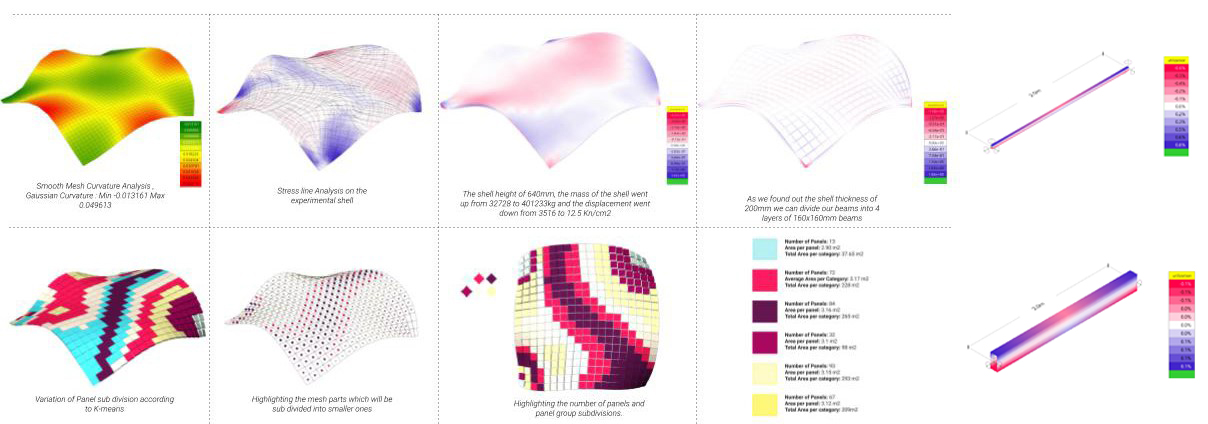Our project is of a timber grid shell. It is a structure with the shape and strength of a double-curvature shell and uses timber instead of being a solid surface. The project is located in Samanes Park in Guayaquil, Ecuador.

The typology was understood initially by looking at different boundary surfaces and support systems. Different boundary surfaces starting from Rectangular, circular, and complex shapes were explored. Curvature Analysis was analyzed to see where the shell experienced the most bending and intensity. The structural optimization analysis was carried out to see how the main beams and the secondary beams behave.

To analyze the cross sections, one spruce of laminated timber of 17 x 17 mm was used and stacked together to get the desired cross-section of 50 mm. The desired surface curvature and then the principal stress lines were analysed along with the cross-section optimization for the shell. The curvature analysis was further used to determine the panel subdivision to understand the different curvature panels that can be obtained.

These analyses on a simple shape led us to apply the same rules on the shell developed as per our site and programmatic needs. The whole process was decomposed into two parts, one with the opening and one without the opening. Initially, the shell displacement analysis was carried out. We discovered that the maximum displacement is 10.7 cm on a constant load of -2.5 kilo newton. Then, the principal stress lines for the shell were analysed and optimised to achieve a shell cross-section of 200 mm. This further can be divided into four layers of 50 x 50 mm beams stacked together.

The same analysis about displacement and cross-section was carried out for a variation with the opening. The maximum displacement is 14.6 cm for the optimized shell. Considering 50×50 mm members, the cross-section displacement obtained for members in this case was 6.9 cm. While using GLT 36 H for the cross-section, we can have 828 members of the main beams and secondary beams of 4900 members with the grid size being 1.5 meters. Regarding the structural optimization for the stress, the shell mass went from 32,728 to 62,000 kg after studying the buckling. The displacement went down from 10.5 to 6.69 cm.

The buckling analysis of the whole structure was carried out considering the load combination of the dead loads and the wind loads. The buckling factor without having any edge beams came up to around 3.45. With edge beams, the buckling load factor increased with the value being around 7.52. The materiality and joint systems between the members were explored with shell thickness considered as 200 mm. The cross section of GLT36H with 50 mm members stacked up as four layers were considered. This could be done in two ways either by using butt or lap joints.

The principal stress for the base shell without the opening and with the opening was studied. With the openings, the minimum stress is -0.36 and the maximum is 0.189, which is higher than when we have an opening. Further, the paneling analysis for our final form and how the subdivisions work along the curvature lines were explored too.

For the lifecycle stages of a building, referring to the book- The Institute of Structural Engineers, “How to Calculate Embodied Carbon”, we considered ground-bearing slab as plywood, timber for shell structure, and glass as a material for our enclosure. The production, transportation waste, and life recycling potential was calculated. In the case of timber and plywood, the bicarbon sequestration was considered. This gave a total of 132.39 tons of CO2 which places us in green A in the SCORS.


